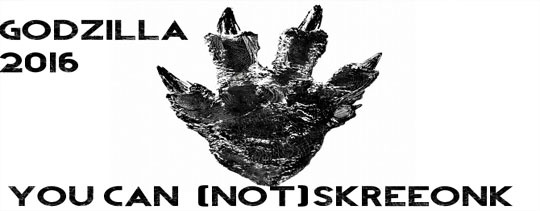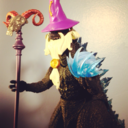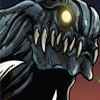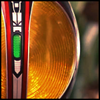TALKBACK #27: Godzilla Tokyo SOS
Moderator: Controllers
-

jellydonut25 - Controller
- Posts: 18874
- Joined: Wed Dec 01, 2004 1:18 am
- Location: Houston, TX via Buffalo, NY
-

Hybrid Gojira - Burning Godzilla
- Posts: 4372
- Joined: Sun Jul 20, 2003 1:04 pm
- Location: Cincinnati, Ohio
Re: TALKBACK #27: Godzilla Tokyo SOS
Nothing about this movie feels Showa to me.
Those movies were character-driven. This movie is monster-battle-driven. The monster battles are cool, and the movie makes for a fun music video or something where everything is just edited together, but it makes for a boring film to watch.
Of all the Millenium films, G2K probably feels the most "Showa" to me. A lot of elements from its approach (just another Godzilla adventure) to the alien invasion sub-plot to the well-fleshed-out characters feel like a more old-school Godzilla film.
Those movies were character-driven. This movie is monster-battle-driven. The monster battles are cool, and the movie makes for a fun music video or something where everything is just edited together, but it makes for a boring film to watch.
Of all the Millenium films, G2K probably feels the most "Showa" to me. A lot of elements from its approach (just another Godzilla adventure) to the alien invasion sub-plot to the well-fleshed-out characters feel like a more old-school Godzilla film.
-

jellydonut25 - Controller
- Posts: 18874
- Joined: Wed Dec 01, 2004 1:18 am
- Location: Houston, TX via Buffalo, NY
Re: TALKBACK #27: Godzilla Tokyo SOS
Eh, G2K has a few cool moments but falls flat on its face for me.
-

Hybrid Gojira - Burning Godzilla
- Posts: 4372
- Joined: Sun Jul 20, 2003 1:04 pm
- Location: Cincinnati, Ohio
-

jellydonut25 - Controller
- Posts: 18874
- Joined: Wed Dec 01, 2004 1:18 am
- Location: Houston, TX via Buffalo, NY
Re: TALKBACK #27: Godzilla Tokyo SOS
Other than the action figure looking Godzilla, this film has some of the better effects in the series. Other than that, theres not much to really talk about.

-

Gojilove - Godzilla
- Posts: 558
- Joined: Tue Jul 06, 2004 8:38 pm
- Location: Chicago
Re: TALKBACK #27: Godzilla Tokyo SOS
I had to wait 6 months to watch it, but I thought it was great, my opinion has diminished quite a bit, but I still enjoy it.
"We Can't Stop Here, This is Bat Country!"


-

MekaGojira3k - Millennium Godzilla
- Posts: 18288
- Joined: Sat Aug 09, 2003 11:13 am
- Location: Ky, USA
-

klen7 - Meltdown Godzilla
- Posts: 7303
- Joined: Wed Dec 21, 2011 11:34 pm
- Location: beyond your peripheral vision
Re: TALKBACK #27: Godzilla Tokyo SOS
Is this still a movie about the original Godzilla's bones becoming sentient and learning to express its admiration for the human race through written language?
Yep, still not interested.
Yep, still not interested.
-

Zack Metoyer - Godzilla
- Posts: 565
- Joined: Tue Sep 20, 2005 12:44 pm
- Location: Michigan, USA
-

jellydonut25 - Controller
- Posts: 18874
- Joined: Wed Dec 01, 2004 1:18 am
- Location: Houston, TX via Buffalo, NY
Re: TALKBACK #27: Godzilla Tokyo SOS
"We Can't Stop Here, This is Bat Country!"


-

MekaGojira3k - Millennium Godzilla
- Posts: 18288
- Joined: Sat Aug 09, 2003 11:13 am
- Location: Ky, USA
Re: TALKBACK #27: Godzilla Tokyo SOS
You're right, I think it'd be better explained as a film about an old guy and a little boy who move chairs and desks around.
-

Zack Metoyer - Godzilla
- Posts: 565
- Joined: Tue Sep 20, 2005 12:44 pm
- Location: Michigan, USA
Re: TALKBACK #27: Godzilla Tokyo SOS
"We Can't Stop Here, This is Bat Country!"


-

MekaGojira3k - Millennium Godzilla
- Posts: 18288
- Joined: Sat Aug 09, 2003 11:13 am
- Location: Ky, USA
Re: TALKBACK #27: Godzilla Tokyo SOS
Does anyone else think that the end of the film, the trench Kiryu flies Godzilla to is where they first emerged?
-

Jorzilla - Heisei Godzilla
- Posts: 1512
- Joined: Sat Aug 09, 2003 2:39 am
- Location: Seattle
Re: TALKBACK #27: Godzilla Tokyo SOS
I watched Tokyo SOS for the first time recently and while there are a few fun moments throughout, its a rather forgettable film. As said before, the characters aren't fleshed out enough to stand out in the story. I didn't care about anything going on with Yoshita, which is sad when he's one of the main people we're following. And while the cameo of the character Akane was cool to see, I REALLY wish she was in the movie more (half of it is just me fanboying over the actress, but its also because she could have brought a bit more weight to the story). I will say that it was fun to play "Spot the hero toku actor" in this movie as we had GaoRed, the return of Kamen Rider Gills and another actor from Kamen Rider Agito that I can't seem to remember the name of ATM. Lot of recognizable actors outside of those as well, which was cool to see.
As for the action in the movie, there were some cool moments involving insanely detailed destructible miniatures, but Tokyo SOS felt like it was running through the motions for me. Even with my limited Godzilla experience, it didn't feel like anything new was going on here. It went through a few similar beats as Godzilla Against MechaGodzilla which was a bit of a disappointing. It wasn't necessarily boring, but there is a feeling that more could have been done to make it stand out.
As for the action in the movie, there were some cool moments involving insanely detailed destructible miniatures, but Tokyo SOS felt like it was running through the motions for me. Even with my limited Godzilla experience, it didn't feel like anything new was going on here. It went through a few similar beats as Godzilla Against MechaGodzilla which was a bit of a disappointing. It wasn't necessarily boring, but there is a feeling that more could have been done to make it stand out.
-

Inui Takumi - Little Godzilla
- Posts: 108
- Joined: Thu Sep 05, 2013 2:21 pm
Re: TALKBACK #27: Godzilla Tokyo SOS
Toho’s millennium series had featured a bunch of stand-alone movies with each one following the original attack in 1954. It seems like an odd move, but one people were getting used to as it meant a new director could come in and build their own universe without any already established rules and regulations. Despite this bold new direction, “Godzilla Against MechaGodzilla” left an odd taste in audiences’ mouths as the movie felt anticlimactic when the credits rolled. As it turned out, this was only the first of a two part story to tell.
“Godzilla x Mothra x MechaGodzilla Tokyo S.O.S.” (Godzilla: Tokyo SOS for short) begins just a little over a year after the previous movie’s conclusion. Kiryu is in repair and Godzilla has disappeared from existence. In the meantime, two fairies and Mothra appear before Shinichi Chujo who helped them once before, and his family, begging for the bones of Godzilla found within Kiryu’s structure to be returned to the ocean where they belong. Unfortunately, Shinichi’s nephew, Yoshito, is one of the engineers who maintain Kiryu’s computer systems and disagrees with them, stating that Kiryu is the only hope humanity has against Godzilla. This brings about an interesting conflict into the mix as the fairies promise that Mothra will defend Japan against Godzilla, while others believe Kiryu is the best weapon they have to battle the nuclear monstrosity. Nevertheless, it takes the might of both monsters to defend Japan from Godzilla’s wrath.
Unlike the previous movie, this one centers around two main characters, which one would expect means more characters development. Unfortunately that is not the case. The development given for Shinichi is based off him being the same character from the original “Mothra.” As such, very little is focused on him. On the positive end of the stick, the movie smartly focuses pretty much its time on the maintenance crew of Kiryu rather than mixing it up with the pilots included. Yoshito has a friend who is a pilot, along with the stereotypical rival, but the main focus on solely on Yoshito. Sadly, this does not help develop his character, however, as he is a pretty bland one altogether. I am not sure what it is with his actor Noburo Kaneko, but the man seems like he is half asleep during his performance here. In fact, he seems to be like that in everything I have seen him in that came out after “GaoRanger.” Either he is stoned out of his mind at all times or he just is not that good of an actor. I get that his character is supposed to love machines, but the man is one step away from having the personality of a machine. He even makes Akane appear to have emotions.
Moving on, the plot itself is okay, but pretty generic. It has features more homages to Toho’s movies of the past, which is nice, but the movie is really just one long final battle. Godzilla climbs onto land, wreaks havoc, Mothra appears to battle him, Kiryu appears, and then the battle is over. It makes one wonder why this could not have all been just one 2 hour movie instead of two 90 minute movies. There is enough plot between the two that the entire story could have been told in 120 minutes.
As I just said though, this movie is all about the monster action, and there is a lot of it. The effects on Mothra are done quite terrifically. Her wings move in a realistic manner, flapping when they need to be, a far better feat than the Mothra they did in the Heisei series. The wingspan has also been improved upon from the last few movies Mothra had appeared in, which is another treat to see. I love the idea behind Mothra in “GMK,” but her wings were too small. My only complaint would be that I do miss the yellow colored fur she had back in the Showa era. While the Mothra in this movie could be a different one, but the way it is implied it is the same one that attacked Japan in the 60s, so they should have kept her coloring the same. The larvae Mothras are vastly superior to how they were portrayed during the Heisei era, as they actually look like they are crawling against the ground instead of just being pulled. Overall, there really are no complaints to be had on either form of Mothra.
The designs for both Kiryu and Godzilla are carried over from the last movie with subtle differences. Kiryu’s arm and Absolute Zero Cannon were previously damaged, so they have been replaced with items that have a different design. Kiryu’s new arm has differences from his other, including the ability to turn into a drill, breaking up the machine’s symmetry. While the brand new maser system that is placed inside Kiryu’s chest is a step down from the Absolute Zero Cannon as far as power is concerned, it feels more natural because it can be used more since it is not as powerful. I tend to things these two cannons should have been reversed, but then, it goes to show that the stronger weapon may not be the most efficient. Finally, the brand new weapons attachment pack on Kiryu is decent, but does not look anywhere near as good as the one from the first movie does. It does its job though, which is really all that matters.
Godzilla’s biggest difference is that he has a giant scar on his chest. This is something nice to see as it shows there was an impact from his last encounter. It is also nice to state that Godzilla no longer stands still when he is being shot at, which is one of the best improvements this movie has made. This is probably also the single reason this movie is superior to the first one. Of course, the movie also builds up the threat of Godzilla, something that was sorely missed last time. The battle with Mothra is also done nicely even if it does feel familiar. Overall, there is nothing to complain about Godzilla this time around.
In the end, this movie fixes some issues that the first one had, but at the same time, also negates some of its positives. For what it is worth though, not having Godzilla just stand like a doll and be shot at makes for a vast improvement over what was shown before, and that alone makes this one the better movie. Unfortunately, the character development is minimal, if there is any at all, as the movie expects the viewer to have already seen “Mothra” in order to connect with Shinichi and his family. Of course, the ending after the credits really hints that nothing was learned at all by the events that transpired within the movie and that humanity is doomed to repeat the same mistakes over and over again. Nevertheless, the movie does have some excellent monster action, good effects, and another great score from Oshima, so I give it a 6/10.
“Godzilla x Mothra x MechaGodzilla Tokyo S.O.S.” (Godzilla: Tokyo SOS for short) begins just a little over a year after the previous movie’s conclusion. Kiryu is in repair and Godzilla has disappeared from existence. In the meantime, two fairies and Mothra appear before Shinichi Chujo who helped them once before, and his family, begging for the bones of Godzilla found within Kiryu’s structure to be returned to the ocean where they belong. Unfortunately, Shinichi’s nephew, Yoshito, is one of the engineers who maintain Kiryu’s computer systems and disagrees with them, stating that Kiryu is the only hope humanity has against Godzilla. This brings about an interesting conflict into the mix as the fairies promise that Mothra will defend Japan against Godzilla, while others believe Kiryu is the best weapon they have to battle the nuclear monstrosity. Nevertheless, it takes the might of both monsters to defend Japan from Godzilla’s wrath.
Unlike the previous movie, this one centers around two main characters, which one would expect means more characters development. Unfortunately that is not the case. The development given for Shinichi is based off him being the same character from the original “Mothra.” As such, very little is focused on him. On the positive end of the stick, the movie smartly focuses pretty much its time on the maintenance crew of Kiryu rather than mixing it up with the pilots included. Yoshito has a friend who is a pilot, along with the stereotypical rival, but the main focus on solely on Yoshito. Sadly, this does not help develop his character, however, as he is a pretty bland one altogether. I am not sure what it is with his actor Noburo Kaneko, but the man seems like he is half asleep during his performance here. In fact, he seems to be like that in everything I have seen him in that came out after “GaoRanger.” Either he is stoned out of his mind at all times or he just is not that good of an actor. I get that his character is supposed to love machines, but the man is one step away from having the personality of a machine. He even makes Akane appear to have emotions.
Moving on, the plot itself is okay, but pretty generic. It has features more homages to Toho’s movies of the past, which is nice, but the movie is really just one long final battle. Godzilla climbs onto land, wreaks havoc, Mothra appears to battle him, Kiryu appears, and then the battle is over. It makes one wonder why this could not have all been just one 2 hour movie instead of two 90 minute movies. There is enough plot between the two that the entire story could have been told in 120 minutes.
As I just said though, this movie is all about the monster action, and there is a lot of it. The effects on Mothra are done quite terrifically. Her wings move in a realistic manner, flapping when they need to be, a far better feat than the Mothra they did in the Heisei series. The wingspan has also been improved upon from the last few movies Mothra had appeared in, which is another treat to see. I love the idea behind Mothra in “GMK,” but her wings were too small. My only complaint would be that I do miss the yellow colored fur she had back in the Showa era. While the Mothra in this movie could be a different one, but the way it is implied it is the same one that attacked Japan in the 60s, so they should have kept her coloring the same. The larvae Mothras are vastly superior to how they were portrayed during the Heisei era, as they actually look like they are crawling against the ground instead of just being pulled. Overall, there really are no complaints to be had on either form of Mothra.
The designs for both Kiryu and Godzilla are carried over from the last movie with subtle differences. Kiryu’s arm and Absolute Zero Cannon were previously damaged, so they have been replaced with items that have a different design. Kiryu’s new arm has differences from his other, including the ability to turn into a drill, breaking up the machine’s symmetry. While the brand new maser system that is placed inside Kiryu’s chest is a step down from the Absolute Zero Cannon as far as power is concerned, it feels more natural because it can be used more since it is not as powerful. I tend to things these two cannons should have been reversed, but then, it goes to show that the stronger weapon may not be the most efficient. Finally, the brand new weapons attachment pack on Kiryu is decent, but does not look anywhere near as good as the one from the first movie does. It does its job though, which is really all that matters.
Godzilla’s biggest difference is that he has a giant scar on his chest. This is something nice to see as it shows there was an impact from his last encounter. It is also nice to state that Godzilla no longer stands still when he is being shot at, which is one of the best improvements this movie has made. This is probably also the single reason this movie is superior to the first one. Of course, the movie also builds up the threat of Godzilla, something that was sorely missed last time. The battle with Mothra is also done nicely even if it does feel familiar. Overall, there is nothing to complain about Godzilla this time around.
In the end, this movie fixes some issues that the first one had, but at the same time, also negates some of its positives. For what it is worth though, not having Godzilla just stand like a doll and be shot at makes for a vast improvement over what was shown before, and that alone makes this one the better movie. Unfortunately, the character development is minimal, if there is any at all, as the movie expects the viewer to have already seen “Mothra” in order to connect with Shinichi and his family. Of course, the ending after the credits really hints that nothing was learned at all by the events that transpired within the movie and that humanity is doomed to repeat the same mistakes over and over again. Nevertheless, the movie does have some excellent monster action, good effects, and another great score from Oshima, so I give it a 6/10.

-

Dr Kain - Millennium Godzilla
- Posts: 11930
- Joined: Mon Jul 28, 2003 4:00 pm
- Location: Englewood CO but originally from Buffalo NY
Re: TALKBACK #27: Godzilla Tokyo SOS
^GMMG: Tokyo SOS was better than GxMG. I also liked how they tied in the first original Mothra movie into this one. Also. Anyone care to guess what experiment they're about to conduct from these end credit images?
Here we have Godzilla's DNA...
Anyone know the name of the kaiju DNA above Godzilla's which is dated 10/7/1987?
My Japanese is rusty, but I would really like to know what that says in the lower right corner.
Here we have Godzilla's DNA...
Anyone know the name of the kaiju DNA above Godzilla's which is dated 10/7/1987?
My Japanese is rusty, but I would really like to know what that says in the lower right corner.
- Russzilla
- Heisei Godzilla
- Posts: 1304
- Joined: Thu Sep 12, 2013 7:31 pm
- Location: London, KY via Boston/Philadelphia
-

Benjamin Haines - Meltdown Godzilla
- Posts: 6004
- Joined: Wed Apr 28, 2004 3:38 pm
- Location: North Carolina
- Russzilla
- Heisei Godzilla
- Posts: 1304
- Joined: Thu Sep 12, 2013 7:31 pm
- Location: London, KY via Boston/Philadelphia
Re: TALKBACK #27: Godzilla Tokyo SOS
http://legion1979.tumblr.com/
Hello, Nice Warners! - A Thorough Analysis of Every Animaniacs Episode
Hello, Nice Warners! - A Thorough Analysis of Every Animaniacs Episode
- Legion
- Meltdown Godzilla
- Posts: 7303
- Joined: Fri Aug 15, 2003 8:11 pm
- Location: Long Island, NY
-

jellydonut25 - Controller
- Posts: 18874
- Joined: Wed Dec 01, 2004 1:18 am
- Location: Houston, TX via Buffalo, NY
Re: TALKBACK #27: Godzilla Tokyo SOS
I was chatting with some one that was admittedly not a big Mothra fan about this movie and the conversation basically turned into what if Mothra was the dead kaiju that washed up in the beginning. I was initially ready to dismiss it, but when you think about it, that could have completely changed the tie in a more realistic manner. Rather than Mothra visiting Dr Chujo (and no one noticing) he would find himself reminiscing at the startling news of Mothra's death and then the human link becomes more relevant when the larva show up to put things right... its a bit darker in tone than the movie they made, but i really could see it working.
(Granted I am glad they worked in Kameobas into the G universe but its an interesting alternative)
(Granted I am glad they worked in Kameobas into the G universe but its an interesting alternative)
-

klen7 - Meltdown Godzilla
- Posts: 7303
- Joined: Wed Dec 21, 2011 11:34 pm
- Location: beyond your peripheral vision
-

Hybrid Gojira - Burning Godzilla
- Posts: 4372
- Joined: Sun Jul 20, 2003 1:04 pm
- Location: Cincinnati, Ohio
Re: TALKBACK #27: Godzilla Tokyo SOS
I like SOS more than GxMG,
but I feel like a lot of the character and story stuff is stronger in GxMG.
but I feel like a lot of the character and story stuff is stronger in GxMG.
"We Can't Stop Here, This is Bat Country!"


-

MekaGojira3k - Millennium Godzilla
- Posts: 18288
- Joined: Sat Aug 09, 2003 11:13 am
- Location: Ky, USA
Return to The Millennium Era: 1999-2005
Who is online
Users browsing this forum: No registered users and 24 guests


